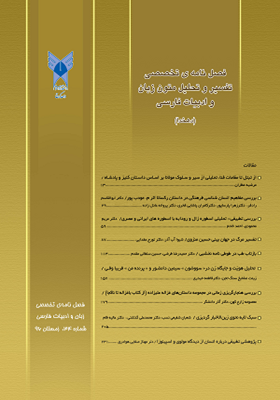از تبتّل تا مقامات فنا تحلیلی از سیر و سلوک مولانا بر اساس داستان کنیز و پادشاه
محورهای موضوعی : متون زبان و ادبیات فارسی
1 - کارشناس ارشد زبان و ادبیات فارسی،آموزش و پرورش شیراز،شیراز،ایران
کلید واژه:
چکیده مقاله :
دیدار شمسالدّین تبریزی و مولانا جلالالدین محمّد بلخی یکی از پدیدههای شگفتانگیز پربرکت در تاریخ عرفان اسلامی است که برکات آن در شخصیت و آثار جاودانهی مولانا بر صحیفهی روزگار ماندگار شده است. امّا این ارتباط انسانساز در هالهای از داستانی بیمایه پنهان شده است که در آن ضمن پرسشی پیامبر اکرم (ص) با بایزید مقایسه میشوند. در این جستار نگارنده کوشیده است تا با تکیه بر داستان کنیز و پادشاه که نقد حال مولاناست سلوک معنوی او را تبیین کند بر این تقدیر این نتیجه بهدست آمده که آنچه در اعترافات روشن مولانا و انتقالات ذهنی زبانی او در باب شمس مطرح شده محصول فعالیّتی سنگین از اندیشهوری و سلوک عملی و حالات و کیفیّات حاصل از آنهاست که در عرفان عملی و اعمال عرفانی شناخته شده است. به گمان ما چنین جریانی امری دفعی و ناگهانی نیست. زمینهها، انگیزهها، سببها، کارها و شرایط ویژه باید تا کسی به مقام معرفت برسد و بتوان او را عارف خواند. این داستان آینهای روشن از مراتب و منازل عرفان عملی است که پلّه پلّه از تبتّل تا مقامات فنا و وصول به اوج عرفان که جزیی از ولایت است در آن مطرح شده است و تحوّلات روحی و معنوی مولانا را در منازلی چون: طلب، انقطاع الی الله، ظهور پیر، تبدیل مزاج روحانی و نهایتاً ولایت واکاوی کرده است.
The visitation of Shams Al-din Tabrizi and Molana Jalal Al-din Mohammad Balkhi Rumi is a wonderful phenomenon in the history of Islamic mysticism, and its outcome has stayed in Rumi’s personality and his everlasting works. This humanitarian relationship, however, has been obscured behind a frail story in which the great prophet of Islam is compared with Bayazid Bastami through a question. In this study, the writer has tried to specify Rumi’s spiritual path based on the biographical-like story of “The Handmaiden and The King”. The results have revealed that whatever has been considered in Rumi’s clear professions and his mental-verbal statements about Shams is the product of the substantial activity of reflection and practical spiritual path and acquired moods and qualities that have been identified in practical mysticism and mystical practices. A circulation such as this is not believed to be accidental. There should be contexts, motives, reasons, works and particular conditions there so that someone could achieves spiritual station of cognition and we can call him a mystic. This story of the handmaiden and the king is an explicit mirror of the path and stages of practical mysticism in which everything – from overcoming the self to spiritual stations of annihilation and attainment of the apex of mysticism that is a part of sainthood – has been discussed step by step and Rumi’s inner and spiritual transitions in stages such as pursuit, attachment to God, appearance of the sage, transformation of spiritual temper and finally friendship are investigated
_||_

